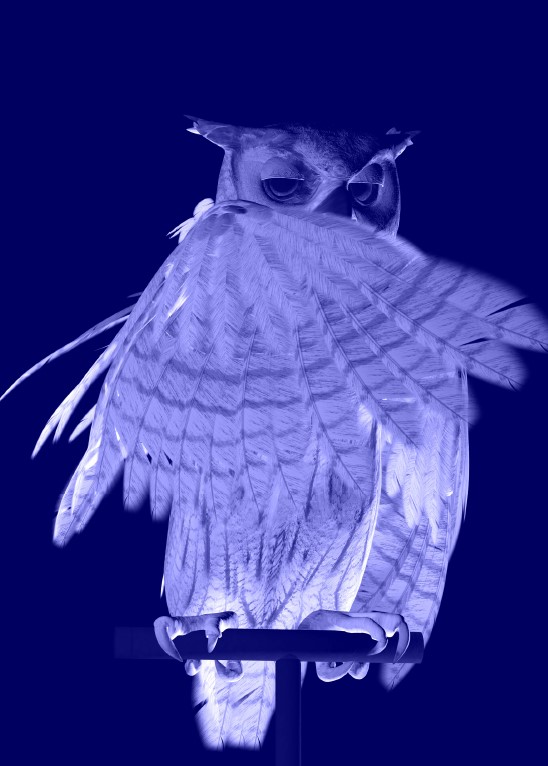Oracles, Owls...Some Animals Never Sleep

Oracles, Owls...some animals never sleep is a series of works by artist Ann Lislegaard created between 2012-2019. One of these works, Oracles, Owls...some animals never sleep, blue, is installled at the House of Innovation on Norrtullsgatan. It is a video work showing an animated owl acting as oracle.
The Owl of Minerva 4.0: Knowledge and Predictions in the Digital Age
In Roman mythology, the owl traditionally represented and accompanied Minerva, the goddess of wisdom. Ever since, the owl has been used as a symbol for knowledge, wisdom, and perspicacity. In Ann Lislegaard’s work, the owl of Minerva has left the physical world, transformed into a digital being appearing to live its own life as voices, words, sentences, and sounds pass through its robotic body, fuelled by machine learning and artificial intelligence. As such, Lislegaard’s owl raises questions about the dramatic change in the production of knowledge in today’s economy, conveyed through the 4th industrial revolution, where machines have gone from simpler functional tools to sophisticated knowledge manufacturers. It urges us to ponder: have the machines started to replace humans as knowledge producers? How should we interact and treat these new beings in business and society?
Lislegaard has referred her owl of Minerva 4.0 as an oracle. Oracle, comes from the word orare which means to speak, referring to the predictions uttered by the priests of priestesses in ancient Greece. The Oracles were regarded as communication portals between the gods and the people. Nonetheless, the people treated their words with care, as their predictions were not always correct. Hence, the oracles claims of truth were limited forcing people to use their own human judgment. In relation to Liislegaards owl, this is a human factor we indeed have to use as we try to make sense of its fragmented and prophetic utterances. This can be seen to point to how decision makers, more and more dependent on the “divine” predictions conveyed by contemporary technology, perhaps have to be more human to make sense of a digital world.
How did these works come about?
“A few years ago, I saw Blade Runner by chance when I turned on the television in a hotel room in Amsterdam. I had seen the film several times before, and I had also read Philip K. Dick’s novel, but this time, I was utterly fascinated by the owl. What I saw made me think about the potential narratives that lie hidden within the silence of objects.
So it made me think:
What if this intriguing and secretive creature were to suddenly receive a voice? What would it say, and how would it say it? This was the initial idea for the piece: giving this animal a voice.
My owl became an Oracle. Just like the Science Fiction genre, it serves as a sort of oracle–a prediction of the future... or, a way to address things that we might otherwise find it difficult to speak about. The oracle is a trickster, both friendly and unfriendly. It seems to make sense but doesn’t, being almost incomprehensible, on the very edge of what we can understand. It speaks in tongues, as if the information passed through its body. It is just as preoccupied with breaking down categories and machines as it is with building them up. Voices, words, sentences, and sounds pass through its robotic body. They are channelled, like a monologue of aphorisms and strangely latent fragments that could be prophecies from the I Ching, or a queer feminist speaking in tongues. You might notice that the soundtrack from the film flows through it as well, in a speeded up and often compressed form.
Naturally, the work isn’t just connected to the film Blade Runner, but also to the novel by Philip K. Dick. When he wrote the book, he often used predictions from the I Ching–the Book of Changes–to guide the narrative and determine which way it should turn or go next. Curiously, Philip K Dick was writing a book called The Owl in Daylight when he died in 1982.”
Ann Lislegaard in an interview. Source: CFHILL.
Oracles, Owls...some animals never sleep, blue
Ann Lislegaard, 2012-2018
Video animation